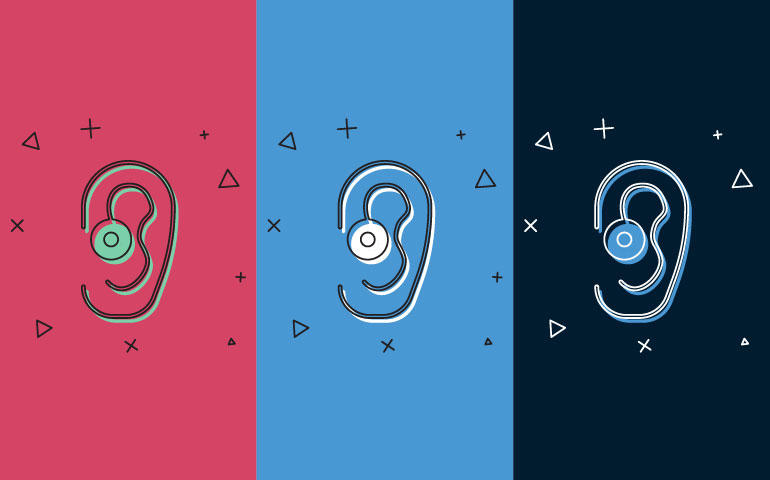Musicians living with hearing loss can now get back into the studio thanks to innovative technology

Happy World Music Day! To celebrate, Gitte Aabo, explores the types of technology that are assisting those with hearing loss to return to the recording studio with confidence.
It may not come as a surprise that musicians are at a far greater risk of hearing loss and tinnitus than their non-musical counterparts. In fact, research has found that musicians are nearly four times as likely to suffer noise-induced hearing loss (NIHL) – caused by repeat or acute exposure to loud sound – than those in any other profession. While NIHL can be avoided, most hearing loss results from non-preventable causes, such as ageing, disease or genetics. Regardless of the cause of hearing loss, each person’s hearing is unique, which is crucial when developing new technologies for the community.
As you can imagine, a hearing loss diagnosis can majorly affect a musician’s life. I experienced this first-hand when working with UK singer-songwriter, Sivu earlier this year on a virtual concert to celebrate World Hearing Day. Sivu, whose real name is James Page, began writing music when he was 16 years old. His alternative pop melodies on an acoustic guitar have brought him great success, resulting in performances on radio and music festivals like Glastonbury. Sivu was diagnosed with Meniere’s Disease in 2013 – a condition that causes dizziness, tinnitus, aural fulness and fluctuating hearing loss. At the concert, it was challenging to hear Sivu describe his initial diagnosis as a ’deaf sentence’ that put his career in jeopardy and prevented him from making music for four years. I feel strongly that the hearing industry has a vital role in helping musicians like Sivu return to the recording studio to do more of what they love. However, although I am motivated by continuous innovation and improvements in hearing technology, developing hearing aids that genuinely work for musicians is challenging.
A key challenge with traditional hearing aids is that they use a standardized approach, modelled on an average ear, but an ‘average’ ear does not exist. The shape of a person’s ear is as unique as their fingerprint, and because of this, the way we hear sound and music is unique to each person. Despite this, most hearing aids collect sound from behind the ear and use an algorithm to replicate the effect of the outer ear on sound waves, making the sound feel artificial to many people. In my opinion, this is similar to the story of the US air force, who famously designed their cockpits to fit an ‘average’ pilot in the 1940s, resulting in a cockpit that didn’t fit anyone and made it impossible to fly the planes safely. Similarly, if we design hearing aids based on the ‘average’ ear, we produce a standardized product and sound that does not reflect how a person would naturally hear.
It excites me that we are constantly innovating our hearing technology to bring the joy of music back into the lives of musicians at GN Hearing. Just last year, we solved one of the biggest challenges facing the hearing industry through the launch of ReSound ONE – the first ever hearing aid to place an additional microphone inside the ear canal, thus collecting sounds as they are “funnelled” by the wearers own ear. The result is an individualized hearing solution that works with each person’s own hearing anatomy. By using the unique shape of the wearer’s outer ear to collect the sound, this new Microphone & Receiver-In-Ear (M&RIE) technology allows people with hearing loss to hear sound and music in a way that is unique to them.
READ MORE:
- Biometric authentication: the good, the bad and the ugly
- You’ve had a breach – how do you successfully roll out an emergency patch?
- How to successfully reopen your office in a post-Covid-19 world
- Common migration pitfalls and how to avoid them
Once launched, we were able to fit Sivu with ReSound ONE hearing aids in the hope of helping him return to the recording studio. I had the pleasure of speaking with Sivu at the World Hearing Day concert earlier this year, who explained how the devices have added ‘so much depth and clarity’ to his music and have made the studio a far less intimidating place. He also explained how his ReSound ONE hearing aids had given him back the ‘colours’ he needs to produce beautiful music. Sivu has plans to release a third album this year, his first since 2017, the focus of which will centre around his renewed hope from his improved hearing. At GN Hearing, we understand that people are unique due to physiology, experience, and perception, so one size cannot possibly fit all. With musicians, this becomes even more apparent as their perception of sound is so finely attuned, and the stakes of hearing loss that is not properly managed are much higher. Ultimately, I believe the hearing industry has a key role in innovating with an unparalleled understanding of our customers at our core to ensure that future solutions meet the true needs of those living with hearing loss.
For more news from Top Business Tech, don’t forget to subscribe to our daily bulletin!
